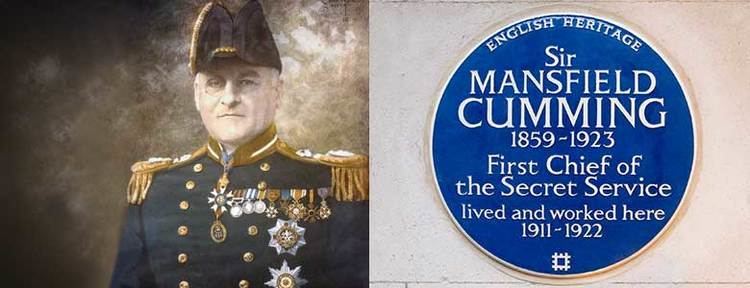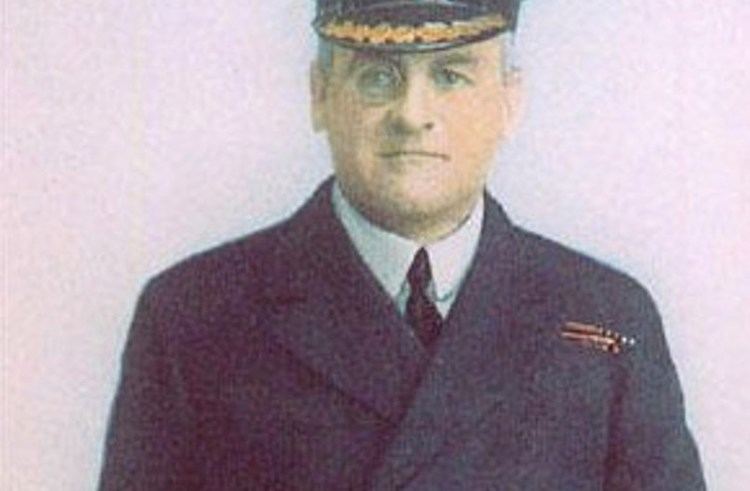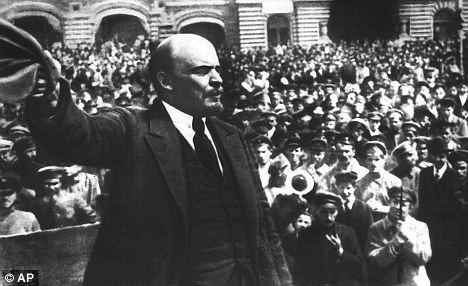Nationality Canadian | Name Mansfield Smith-Cumming | |
 | ||
Active 1878 - 1909 Royal Navy1909 - 1923 SIS (MI6) Died June 14, 1923, London, United Kingdom Organizations founded Secret Intelligence Service Awards Order of St Michael and St George, Order of the Bath | ||
Captain Sir Mansfield George Smith Cumming, (1 April 1859 – 14 June 1923) was the first director of what would become the Secret Intelligence Service (SIS), also known as MI6. In this role he was particularly successful in building an imperial intelligence service.
Contents

Early naval career

He was born into a middle-class family. His father was the great grandson of John Smith (a director of both the South Sea Company and the East India Company), the second son of Abel Smith (d.1756) the Nottingham banker. Smith joined the Royal Navy and underwent training in Britannia at Dartmouth, Devon from the age of twelve and was appointed acting sub-lieutenant in 1878. He was posted to HMS Bellerophon in 1877, and for the next seven years served in operations against Malay pirates (during 1875–6) and in Egypt in 1883. However, he increasingly suffered from seasickness, and in 1885 was placed on the retired list as "unfit for service". Prior to being appointed to run the Secret Service Bureau (SSB), he was working on boom defences in Bursledon on the River Hamble.

He added the surname Cumming after his marriage in 1889 to Leslie Marian Valiant-Cumming, heiress of Logie near Forres in Moray.
Pre-1914

In 1909, Major (later Colonel Sir) Vernon Kell became director of the newly formed Secret Intelligence Bureau (SIB), created as a response to growing public opinion that all Germans living in England were spies. In 1911, the various security organizations were re-organised under the SIB, Kell's division becoming the Home Section, and Cumming's becoming the new Foreign Section (Secret Service Bureau), responsible for all operations outside Britain. Over the next few years he became known as 'C', after his habit of sometimes signing himself with a C eventually written in green ink. This habit became a custom for later directors, although the C now stands for "Chief". Ian Fleming took these aspects for his "M" from the James Bond novels.
In 1914, he was involved in a serious road accident in France, in which his son was killed. Legend has it that in order to escape the car wreck he was forced to amputate his own leg using a pen knife. Hospital records have shown however that while both his legs were broken, his left foot was only amputated the day after the accident. Later he often told all sorts of fantastic stories as to how he lost his leg, and would shock people by interrupting meetings in his office by suddenly stabbing his artificial leg with a knife, letter opener or fountain pen.
Budgets were severely limited prior to World War I, and Cumming came to rely heavily on Sidney Reilly (aka the Ace of Spies), a secret agent of dubious veracity based in Saint Petersburg.
World War I
At the outbreak of war he was able to work with Vernon Kell and Sir Basil Thomson of the Special Branch to arrest twenty-two German spies in England. Eleven were executed, as was Sir Roger Casement, found guilty of treason in 1916. During the war, the offices were renamed. The Home Section became MI5 or Security Service, while Cumming's Foreign Section became MI6 or the Secret Intelligence Service. Agents who worked for MI6 during the war included Augustus Agar, Paul Dukes, John Buchan, Compton Mackenzie and W. Somerset Maugham
When SSB discovered that semen made a good invisible ink, his agents adopted the motto "Every man his own stylo". However, the use of semen as invisible ink was ceased because of the smell it produced for the eventual receiver. It also raised questions over the masturbatory habits of the agents.
Anglo-Irish War
When Britain's Government Committee on Intelligence decided to slash Kell's budget and staff and subordinate MI5 under a new Home Office Civil Intelligence Directorate led by Special Branch's Sir Basil Thomson in January 1919, the powerful MI5/Special Branch partnership that admirably managed counterintelligence and subversives during the war was suddenly thrown into disarray. These bureaucratic intrigues happened at the very moment that the Irish abstentionist party, Sinn Féin, and the Irish Republican Army (IRA) were launching their own independence campaign.
With MI5 reduced to a skeleton staff of just 28 officers and relegated to the sidelines, and with Thomson unable to contain or penetrate the revitalized IRA with a series of clumsy and hastily organized police intelligence operations, it fell to Cumming and SIS (then MI1(c)) to organize a new espionage unit in Ireland, based on continental lines and called the Dublin District Special Branch, in mid-1920.
The DDSB consisted of some 20 line officers drawn from the regular army and trained by Cumming's department in London. Beyond that, however, Cumming began importing some of his own veteran case officers into Ireland from Egypt, Palestine and India, while Basil Thomson organized a special unit consisting of 60 hastily vetted ethnically Irish street agents managed via impersonal communications from Scotland Yard in London.
On Sunday, 21 November 1920, the Headquarters Intelligence Staff of the IRA and its special Counterintelligence Branch (known as "The Squad") under the leadership of IRA Intelligence Chief and IRA Adjutant General Michael Collins, mounted a successful operation to assassinate 14 of Cumming's case officers. While many agents appear to have escaped the IRA execution squads that morning, Whitehall feared that more of its professional agents would be identified and suffer the same fate, and this prompted the hasty withdrawal of most of the remaining SIS agents from Ireland in the days that followed. This was the single greatest catastrophe in the history of the British Secret Service and, according to author Nigel West, Cumming was forever after reluctant to involve the SIS in Irish operations.
A blue plaque in Cumming's name at the SIS headquarters at 2 Whitehall Court was unveiled on 30 March 2015.
